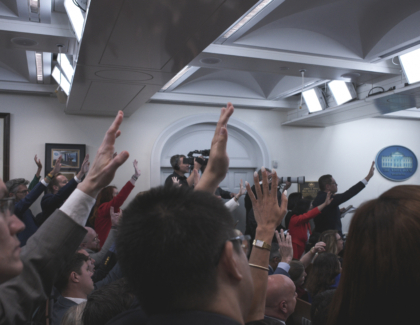Sign up for the daily CJR newsletter.
In late March, just as the pandemic was beginning to ravage the news industry with a slew of furloughs, pay cuts, and more, Ulster Publishing decided to stop the presses for the first time in its forty-seven-year history and go digital-only for its April 1 editions. Geddy Sveikauskas helped launch the first ever edition of the Ulster-owned Woodstock Times as the newspaper’s editor in January 1972. Now Sveikauskas is eighty-two years old and at the helm of the local publishing company, which up until recently published three other hyperlocal weekly papers across the Hudson Valley, including the Kingston Times, New Paltz Times, and Saugerties Times. Only ten weeks after its first cutbacks, in June, Ulster Publishing made another dramatic move: the paper would return, but with only one print product, consolidating all of its titles under the singular Hudson Valley One. “I was killing something I had created,” said Sveikauskas of the steps Ulster took to stay afloat.
The Ulster Publishing titles’ merger is typical of a pattern for publications put under financial stress by the pandemic. The Tow Center has been tracking the economic impact of the coronavirus pandemic on newsrooms, finding that more than five thousand media workers have been laid off, at least seventy-five newsrooms were closed (nine of those have since reopened), and fifty outlets were affected by consolidations, such as Ulster’s four merged titles, since March 2020. While the first round of cutbacks at Ulster meant halting print and permanently laying off twelve staffers, five of which were in editorial positions, the decision to significantly reduce print through consolidation—a move other newsrooms have been experimenting with over the past year—in many ways saved the paper.
The Hudson Valley publishing company is a small, family-owned business, with Sveikauskas’s daughter, Genia Wickwire, helping run operations as the associate publisher. Leading up to the crisis, Ulster was around $120,000 in the red, running on a line of credit and a mortgage loan taken out on Sveikauskas’s house, and falling further behind each year, with little prospect of paying back its debts. “We know everybody who works for us; we have relationships with them,” explained Wickwire. “We were getting into debt because we couldn’t make the hard decisions quickly enough.”
Ulster’s decision to cease separate print editions for each town and instead take a countywide approach to its coverage was a yearslong debate. While the idea to cut certain regions had been floated, Wickwire says they couldn’t bring themselves to desert any of their subscribers altogether. When the pandemic hit, Wickwire says, “the light bulb just lit up,” because they couldn’t leave any part of Ulster County uncovered in the midst of a public health crisis. A single print publication became the obvious choice.
Areas have been blending, and demographics have been changing drastically over time. Wickwire, who is forty-six, grew up in Woodstock and says not a single person she knows lives in their hometown anymore, mostly because they’ve been priced out, as young, wealthy urbanites continue to buy up property in upstate New York. This yearslong trend has only been exacerbated by economic recovery efforts that have brought on a housing boom and growing inequity felt most acutely in Kingston, New York—one of Ulster Publishing’s four main coverage areas.
While there’s much at stake when newsrooms merge or close, it doesn’t always spell immediate disaster. Although Ulster wasn’t able to bring back any of those originally laid off, they’ve spent the past year paying down their debt with the money they’ve saved mostly from printing costs. Now Hudson Valley One plans to use its newfound financial freedom to invest in other aspects of the paper. As Sveikauskas says, “the question becomes, How do we improve editorial, deliver more to the customer, and give the areas the kind of journalism that any area deserves?” For now, the company is looking to hire a new reporter and an editor. More arts and entertainment coverage is also on the horizon.
The move to consolidate has not been without controversy. Many community members donated to the struggling publishing company—Ulster received several hundred donations ranging roughly from $1 to $5,000—while other readers were less sympathetic, saying they’d only subscribe if their specific community’s print paper returned. Wickwire characterized the decision as traumatic while fighting back tears. “For my entire life we had some of these newspapers,” she explained, “but right now we have enough money in the bank this year, and that’s a huge personal relief.”
Wickwire is also emphatic that, despite all the hand-wringing, print is not dead. “We have people begging us to go back to print; we have younger people subscribing,” Wickwire says. After almost two and a half decades of worrying about print becoming obsolete, yet print advertising continuing to make up around 90 percent of Ulster’s income, she believes it’s ultimately a “warped message” that doesn’t tell the whole story—like, for instance, the potential for newspapers to print more intentionally as time passes and circumstances change.
Sveikauskas is confident that the strategic consolidations at Ulster Publishing newspapers can serve as a case study for others. “If you live in a place with a parched area, like a news desert,” he says, “you don’t plant the petunia where it may not rain for several weeks. You focus your energy on the central place where all creatures come for water.” The singular Hudson Valley One print newspaper is, in Ulster Publishing’s opinion, its most viable path forward for life in an industry that continues to resist the threat of extinction.
The Journalism Crisis Project aims to train our focus on the present crisis, fostering a conversation about what comes next. We hope you’ll join us (click to subscribe).
EXPLORE THE TOW CENTER’S COVID-19 CUTBACK TRACKER: Over the past year, researchers at the Tow Center have collected reports of a wide range of cutbacks amid the pandemic. Now there’s an interactive map and searchable database. You can find it here.
Below, more on recent media trends and changes in newsrooms:
- TRIBUNE REPORTERS TAKE BUYOUTS: Last week, Chicago Tribune reporter Josh Noel reported that nearly a quarter of the Chicago Tribune’s reporters would be taking this week’s buyouts. Yesterday, a flood of “personal news” hit Twitter from reporters at the Tribune. “This is not a problem for [the paper’s] new ownership,” David Folkenflik, NPR media correspondent, tweeted. “It will be for the people of Chicago.”
- ALDEN & TRIBUNE “DANCING AT THE EDGE OF THE LAW”: For NiemanLab, Julie Reynolds examined Alden Global Capital’s recent takeover of Tribune Publishing, writing that “the actions of Tribune’s former board come across as self-serving, while the facts suggest violations of both securities and corporate law.” She notes that three Alden-affiliated board members acted in their own interests rather than the interests of shareholders, that Alden founder and Tribune board member Randall Smith held a secret negotiation with interested buyer Stewart Bainum Jr., and that Alden indicated it would be able to pay in cash despite the fact that it was unable to finance a deal as such.
- MASSACHUSETTS STARTUP AIMS TO FILL VOID: In New Bedford, Massachusetts, a group of journalists began a digital startup called the New Bedford Light to fill the void left behind by waning coverage at the local Gannett-owned paper, the New York Times reported. The publication, with a staff of eight, plans to offer in-depth, explanatory investigative journalism, publishing one in-depth article every weekday and omitting old local news staples like police blotters and sports stories. The publication is free for readers. The Light depends on donations, grants, and business sponsorships. “We cannot go down the route of the daily newspaper that tries to do all things for all people,” Barbara Roessner, the publication’s founding editor, told the Times. “The challenge for us is to stay disciplined to do the deeper work and not be caught up in the daily news cycle.”
- A NEW DEAL FOR JOURNALISM: The Forum for Information and Democracy released a 79-page report detailing the possibilities for a New Deal for Journalism. They highlighted a few categories of importance, including supporting the private sector with priority for local media, supporting all forms of public media with insurance for editorial independence, easing the creation of nonprofit outlets, and supporting journalism abroad. (Sarah Scire published a short summary for NiemanLab.)
- DIGITAL NEWS REPORT, 2021: The Reuters Institute released their 2021 Digital News Report, which covers markets accounting for half the world’s population. Among the findings: trust in news increased over the past year, the largest portion of paid subscriptions continue to go to big national brands, and most people are unaware that newspapers are struggling financially, few care, and few want government support for journalism.
- HOW FACEBOOK DEVALUES LOCAL NEWS: For the PopularInfo newsletter, Judd Legum and Tesnim Zekeria explored how Facebook’s algorithm deprioritizes local news. Outlets like the Daily Wire, a site started by right-wing commentator Ben Shapiro, excerpt reporting from other outlets—often local news sites—and give them an incendiary headline or spin. The incendiary version of the piece gets enormous amounts of traffic from Facebook, while the original reporting gets far less. “There are many challenges to profitably running a local media company,” Legum and Zekeria write. “But investing in local reporting only to see your work aggregated and monetized by sites like The Daily Wire is not a formula for economic success.”
- THE TRACE STARTS A PROJECT FOR THE PHILLY COMMUNITY: Nonprofit newsroom The Trace has launched a community engagement project in Philadelphia to connect people affected by gun violence with local resources. “While our past reporting has come in more traditional forms—investigations, profiles, policy articles—we created Up The Block [uptheblock.org] to provide more direct service journalism to the communities most affected by gun violence,” The Trace wrote on Twitter.
- UK NEWSROOM FURLOUGH CLAIMS RECEDE: In the UK, news industry furlough claims hit their lowest point this spring as lockdown measures eased, Charlotte Tobitt reported for PressGazette. Regional publisher Archant, previously the biggest claimant, surpassed breaking even in the first quarter of 2021.
—Lauren Harris
Has America ever needed a media defender more than now? Help us by joining CJR today.









